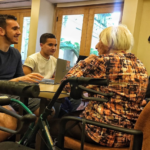Students collaborate to design/build a modern, personal Mishkan & furnishings, incorporating motifs, imagery from the ancient Mishkan, and applying wisdom gained from interviews with senior citizens, exploring: "What makes a quality life, and how can we make life better?" Students then return to Senior Center, using their completed designs as springboard for deeper reflection on how to heal after trauma and how to reach our deepest Human potential.
Entry Narrative
The Mishkan spans an entire book and a half of the Torah, but for many young Jews today, its relevance to modern, Jewish Civilization is not clear. When revisited and analyzed through a sociological and design lens, however, the Mishkan provides tremendous insight into the age-old question: what makes a Quality Life? Beyond this, by sparking conversations about life and God, and by bringing people together, we re-create one of the most essential purposes of the Mishkan: community building through holy collaboration.
The 21st Century Personal Mishkan project is the culmination of a semester-long unit in the 10th Grade Tanach II course (nicknamed “The Mystery of Connection”). The project ties together empathic listening and interviewing, design thinking and collaboration skills, design/architecture theory, sociology/human relations, and Tanach.
Project Outline
1) Students learn reflective listening skills to develop their ability to empathize with a chevruta (and prepare for interviews with senior citizens).
2) Students learn how to use the Quality of Life wheel, and use it to interview family members and senior citizens about their own philosophies regarding: “What makes a quality life” – using reflective listening skills from step 1. (For more on the Quality of Life Wheel, and its use in teaching empathy, click here.)
3. Students learn basic Design and Architecture Theory, including how buildings/furniture transmit values and provide experiences that affect Quality of Life.
4) Students learn about the Mishkan, from the original Torah texts and from G-dcast.
5) Students reflect on how to “intervene” when Quality of Life drops, and how to “fortify” to build resilience. Students journal and using models or digital design, create their own sanctuary, a place to heal one’s Quality of Life, in dialog with the ancient building/furniture.
6) Students collaborate and use “Critical Friends” protocol to improve design. (Video here) Students complete 3 iterations of their design, internalizing the importance of the creative, collaborative process.
7) Students present completed design/models to class, and then share completed Mishkan with residents of Elder Care facility to spark conversation about how to recover from hardship and make the most of life.
Finally, students reflect on what they’ve learned from a) the design process, b) the interviews, and c) the Mishkan material – and how it opens their eyes to their Jewish legacy and its possibility to empower their own lives.
Entry Videos
Audio Files
Mayas-Interview
Online References
- https://drive.google.com/file/d/0ByrBY3F219VDeTF3RXdkeUdLNGc/view?usp=sharing
- https://evanwolkenstein.wordpress.com/2014/02/10/the-quality-of-life-wheel-a-tool-for-reading-life/
- https://evanwolkenstein.wordpress.com/2014/03/20/reflect-rereflect/
- https://drive.google.com/file/d/0B1ZrdjStX2asOXVqR3BXYXlZbUk/view?usp=sharing
- https://docs.google.com/document/d/1-dEAdh8D6SP3lqAgvnsFTA5Na0rOuMfD4QMJi2bwJkA/edit
- https://docs.google.com/document/d/18oHV8CuWCZ0rhhueKQl2kURpWsimJEnLgSoorqRjrGs/edit
- https://drive.google.com/file/d/0B1ZrdjStX2asMkI1Rk9Ed2Q2SUk/view?usp=sharing
- https://docs.google.com/document/d/1PL2QndTrzKJwjW69zxLx9EzykCncSJm1Ro-uIo6_5oA/edit?usp=sharing
- https://docs.google.com/document/d/16DNtJk2fYWlsTjG37190rdIjCIIfpFiVtJrTwX_66cg/edit
- https://voicethread.com/share/715320/
This entry has been tagged with the following terms:
